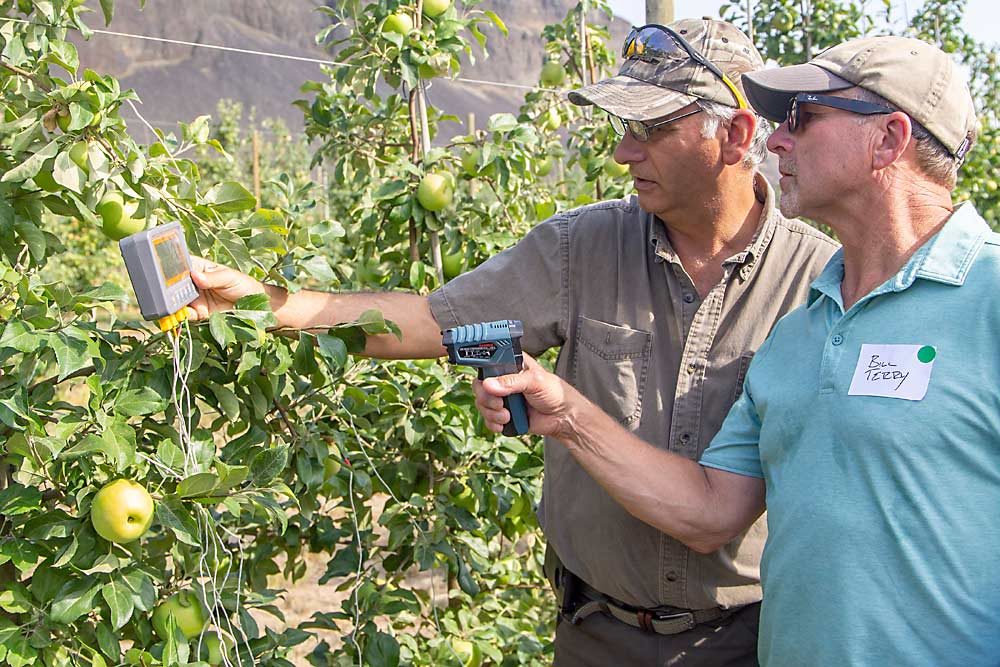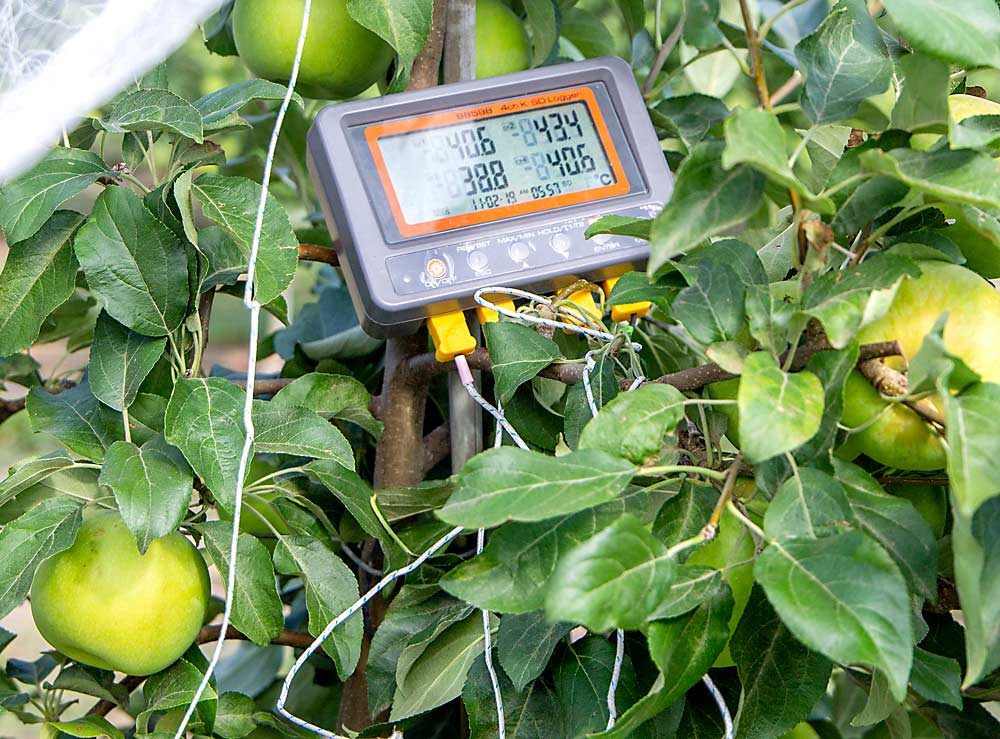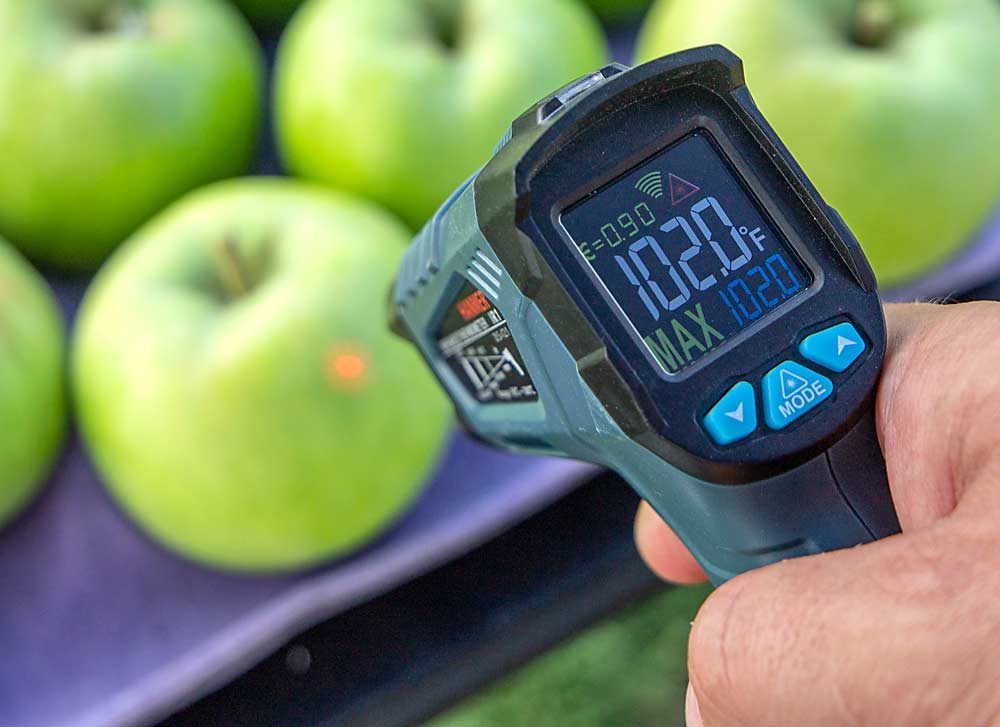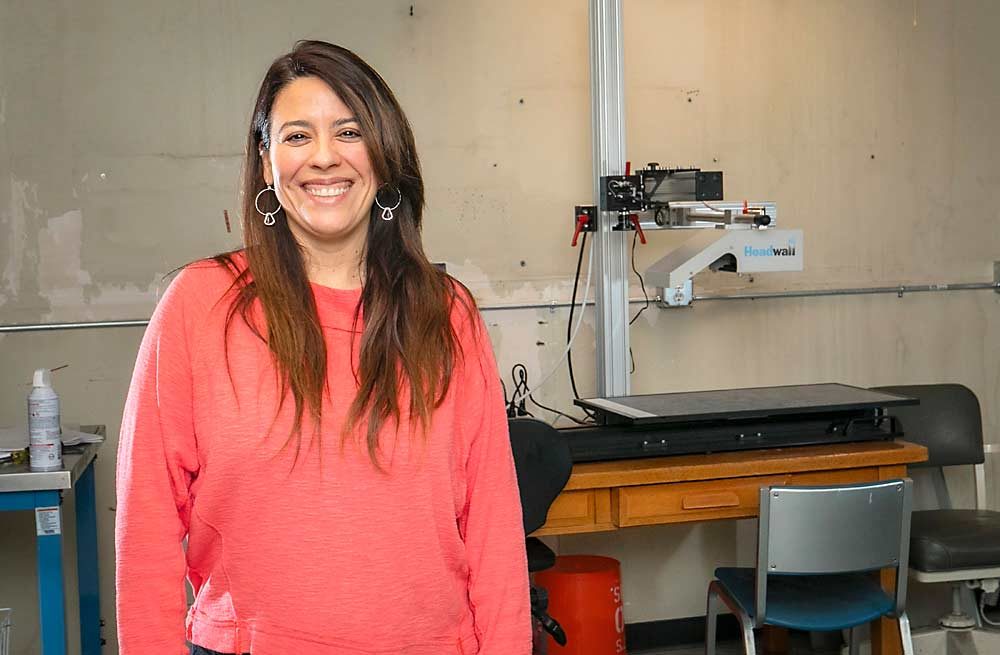
Sunlight powers trees to produce fruit.
But this necessity also serves as a source of stress and damage, so growers in Washington and other hot, dry growing regions are constantly seeking to perfect the balance of exposure to maximize quality and color. It’s a hard balance to strike.
“Sunburn is still the largest source of losses across all cultivars in the state. Even with cooling systems and even with nets, it’s still the major loss,” said Lee Kalcsits, tree fruit physiologist with Washington State University.
In fact, he’s documenting an increase in sunburn incidence. How much climate change is driving that remains unclear; the shift toward narrow, fruiting wall canopies that increase light exposure, over the past decade, also contributes.
“It’s really hard to pull apart the trend of high density, with more sun-exposed fruit, from the general increase in temperature,” he said. Given both climate and horticultural trends, sunburn and the sunscald that sun-damaged fruit develop in storage will be critical issues for the Washington apple industry.
So perhaps it’s not surprising that sun stress has become a renewed research priority at the WSU Tree Fruit Research and Extension Center, for both Kalcsits and postharvest physiologist Carolina Torres. Torres moved to Wenatchee last year from Chile, where sunscald was a major research focus.
While severely sunburned apples never make it to the bin, imperceptibly damaged fruit do, and a significant percentage go on to develop sunscald in storage, Torres said. The two main ways to reduce those losses: detect the at-risk fruit early, so it can be marketed early, and reduce stress in the field in the first place. Research underway aims to improve both.

Systems and susceptibility
Washington growers operate on the general guidance that air temperatures of 95 degrees Fahrenheit or above put fruit at risk for sunburn. That’s why growers typically run evaporative cooling when it’s over 90, unless they’ve swapped cooling systems for netting, which Kalcsits found reduces light intensity and damage without the water use.
But the temperature-to-damage relationship isn’t that simple, Kalcsits said, as the fruit appears to be able to acclimate over time to heat and sun exposure. “We’ll get conditions that really should induce sunburn, and they don’t,” he said.
“We talk about these air temperatures, but we’re finding that depending on the timing, the cultivar, and the fruit development, it really varies,” he said. “We are just starting to scratch the surface of understanding how does fruit even change in their susceptibility to sunburn.”
His lab has launched studies of acclimation — funded by the Washington Tree Fruit Research Commission — in Honeycrisp, Granny Smith and WA 38. The work is still underway, but early findings show Honeycrisp has comparatively higher fruit surface temperature that leads to higher sunburn risk.
Another of the research questions is whether overreliance on evaporative cooling may actually impair the fruit’s natural ability to acclimate to late-season heat and sun exposure. Preliminary data suggests that heat exposure in June, near but below the damage threshold, helps fruit resist sunburn later in the season.
Kalcsits wants to ultimately develop cultivar-specific guidelines for cooling, and he envisions smart, automated cooling systems that run on better risk models.
“There’s always going to be a place for netting and a place for cooling, and economics will drive that,” he said.

But he also aims to tease out the physiological responses to sun stress to understand why some apples are so susceptible and others tolerate it. That could lead to genetic markers to inform the WSU apple breeding program. “Those indicators will allow us to select superior genotypes that allow us to do well in these high light environments,” he said.
So, when August temperatures suddenly spiked to 100 degrees on the afternoon of a WSU field day at Sunrise Orchard, the stage was perfectly set for Kalcsits to talk about his lab group’s new research into fruit acclimation and the physiological processes that explain why some fruit get sunburned and others don’t.
Attendees used hand-held infrared sensors to measure fruit surface temperatures of exposed and shaded apples — just like the researchers do. Fruit surface temperatures in full sun neared 113 degrees and Kalcsits predicted that “in the next couple days, we’re going to see sunburn necrosis in these fruit.”
But they didn’t.
“I was expecting a lot of fruit to be sunburned. There was a little bit of browning, but it was not as substantial as the temperature indicated,” he said in a follow-up interview. The fruit obviously, unexpectedly had the acclimation to allow it to withstand those conditions. “That’s an indication that there is so much more work to do,” he said.
Sensing and storage
Torres’ research also focuses on the physiology underlying the development of sun damage, but she wants to know if early warning signs of the damage can be detected in a nondestructive way.
In Chile, she developed a model that predicted how much sunscald would develop in storage based on the amount and severity of sun damage seen at harvest. It didn’t work as well in the Washington climate, but some form of prediction is key to reducing the cost associated with storing fruit that goes on to develop sunscald.
“Sun stress leads to sunscald, and that has no control. The only way we can control it is to manage the cold chain; this susceptible group of fruit can only manage three months of storage,” she said.
Enter optical sorting.
Torres has already shown that sunburned fruit has much higher levels of phenolic compounds and other physiological changes. Now, she plans to use a hyperspectral imaging system — the same technology that runs packing line sorters — to see if it can detect sun damage that’s invisible to the naked eye and use that information to sort fruit.

Preliminary data with a more basic spectroscopy tool showed the approach can successfully sort sun-exposed fruit from shaded fruit, Torres said. The more robust scanner should be able to develop a more robust index of sun damage to segregate fruit at scale.
“This is just dreaming right now — but having an optical system at the entrance to the warehouse or even in the orchard, they could segregate right there,” she said. “It would separate in terms of most susceptible and less susceptible and you could store the more susceptible one way and the less susceptible another way.”
And it’s not that far-fetched a dream, said David Rudell, a postharvest scientist with the U.S. Department of Agriculture who collaborates with Torres on several research projects. Work he did with Stefano Musacchi, the WSU endowed chair for tree fruit physiology, already showed that pears from different parts of the tree, which received different light exposure, can be sorted by quality with metabolite differences. The next step: sensing those differences with the nondestructive advantage of an optical system.
“We’ve always known fruit behaves differently in the cold chain depending on how much sunlight it receives; people have always color picked,” he said. “This is just a more advanced way to look at the cumulative impact of sunlight.” •
—by Kate Prengaman
Related:
—Sunburn and sunscald: Beware the warning signs – Video






Leave A Comment